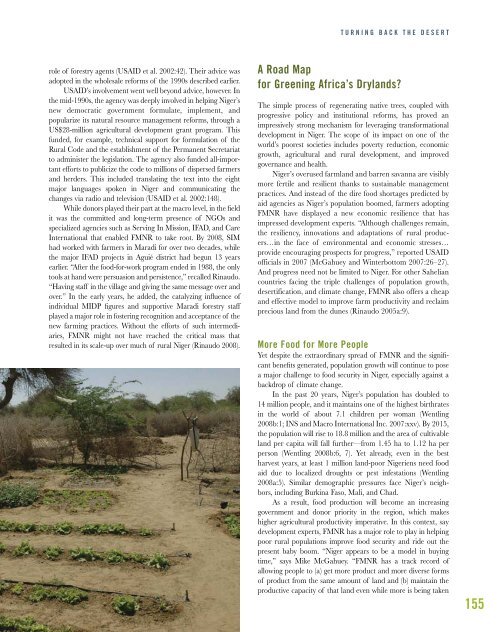Growing the Wealth of the Poor - World Resources Institute
Growing the Wealth of the Poor - World Resources Institute
Growing the Wealth of the Poor - World Resources Institute
You also want an ePaper? Increase the reach of your titles
YUMPU automatically turns print PDFs into web optimized ePapers that Google loves.
T U R N I N G B A C K T H E D E S E R Trole <strong>of</strong> forestry agents (USAID et al. 2002:42). Their advice wasadopted in <strong>the</strong> wholesale reforms <strong>of</strong> <strong>the</strong> 1990s described earlier.USAID’s involvement went well beyond advice, however. In<strong>the</strong> mid-1990s, <strong>the</strong> agency was deeply involved in helping Niger’snew democratic government formulate, implement, andpopularize its natural resource management reforms, through aUS$28-million agricultural development grant program. Thisfunded, for example, technical support for formulation <strong>of</strong> <strong>the</strong>Rural Code and <strong>the</strong> establishment <strong>of</strong> <strong>the</strong> Permanent Secretariatto administer <strong>the</strong> legislation. The agency also funded all-importantefforts to publicize <strong>the</strong> code to millions <strong>of</strong> dispersed farmersand herders. This included translating <strong>the</strong> text into <strong>the</strong> eightmajor languages spoken in Niger and communicating <strong>the</strong>changes via radio and television (USAID et al. 2002:148).While donors played <strong>the</strong>ir part at <strong>the</strong> macro level, in <strong>the</strong> fieldit was <strong>the</strong> committed and long-term presence <strong>of</strong> NGOs andspecialized agencies such as Serving In Mission, IFAD, and CareInternational that enabled FMNR to take root. By 2008, SIMhad worked with farmers in Maradi for over two decades, while<strong>the</strong> major IFAD projects in Aguié district had begun 13 yearsearlier. “After <strong>the</strong> food-for-work program ended in 1988, <strong>the</strong> onlytools at hand were persuasion and persistence,” recalled Rinaudo.“Having staff in <strong>the</strong> village and giving <strong>the</strong> same message over andover.” In <strong>the</strong> early years, he added, <strong>the</strong> catalyzing influence <strong>of</strong>individual MIDP figures and supportive Maradi forestry staffplayed a major role in fostering recognition and acceptance <strong>of</strong> <strong>the</strong>new farming practices. Without <strong>the</strong> efforts <strong>of</strong> such intermediaries,FMNR might not have reached <strong>the</strong> critical mass thatresulted in its scale-up over much <strong>of</strong> rural Niger (Rinaudo 2008).A Road Mapfor Greening Africa’s Drylands?The simple process <strong>of</strong> regenerating native trees, coupled withprogressive policy and institutional reforms, has proved animpressively strong mechanism for leveraging transformationaldevelopment in Niger. The scope <strong>of</strong> its impact on one <strong>of</strong> <strong>the</strong>world’s poorest societies includes poverty reduction, economicgrowth, agricultural and rural development, and improvedgovernance and health.Niger’s overused farmland and barren savanna are visiblymore fertile and resilient thanks to sustainable managementpractices. And instead <strong>of</strong> <strong>the</strong> dire food shortages predicted byaid agencies as Niger’s population boomed, farmers adoptingFMNR have displayed a new economic resilience that hasimpressed development experts. “Although challenges remain,<strong>the</strong> resiliency, innovations and adaptations <strong>of</strong> rural producers…in<strong>the</strong> face <strong>of</strong> environmental and economic stresses…provide encouraging prospects for progress,” reported USAID<strong>of</strong>ficials in 2007 (McGahuey and Winterbottom 2007:26–27).And progress need not be limited to Niger. For o<strong>the</strong>r Saheliancountries facing <strong>the</strong> triple challenges <strong>of</strong> population growth,desertification, and climate change, FMNR also <strong>of</strong>fers a cheapand effective model to improve farm productivity and reclaimprecious land from <strong>the</strong> dunes (Rinaudo 2005a:9).More Food for More PeopleYet despite <strong>the</strong> extraordinary spread <strong>of</strong> FMNR and <strong>the</strong> significantbenefits generated, population growth will continue to posea major challenge to food security in Niger, especially against abackdrop <strong>of</strong> climate change.In <strong>the</strong> past 20 years, Niger’s population has doubled to14 million people, and it maintains one <strong>of</strong> <strong>the</strong> highest birthratesin <strong>the</strong> world <strong>of</strong> about 7.1 children per woman (Wentling2008b:1; INS and Macro International Inc. 2007:xxv). By 2015,<strong>the</strong> population will rise to 18.8 million and <strong>the</strong> area <strong>of</strong> cultivableland per capita will fall fur<strong>the</strong>r—from 1.45 ha to 1.12 ha perperson (Wentling 2008b:6, 7). Yet already, even in <strong>the</strong> bestharvest years, at least 1 million land-poor Nigeriens need foodaid due to localized droughts or pest infestations (Wentling2008a:5). Similar demographic pressures face Niger’s neighbors,including Burkina Faso, Mali, and Chad.As a result, food production will become an increasinggovernment and donor priority in <strong>the</strong> region, which makeshigher agricultural productivity imperative. In this context, saydevelopment experts, FMNR has a major role to play in helpingpoor rural populations improve food security and ride out <strong>the</strong>present baby boom. “Niger appears to be a model in buyingtime,” says Mike McGahuey. “FMNR has a track record <strong>of</strong>allowing people to (a) get more product and more diverse forms<strong>of</strong> product from <strong>the</strong> same amount <strong>of</strong> land and (b) maintain <strong>the</strong>productive capacity <strong>of</strong> that land even while more is being taken155
















